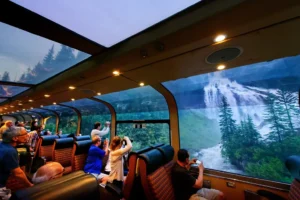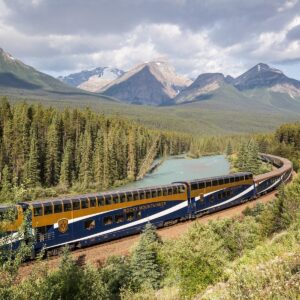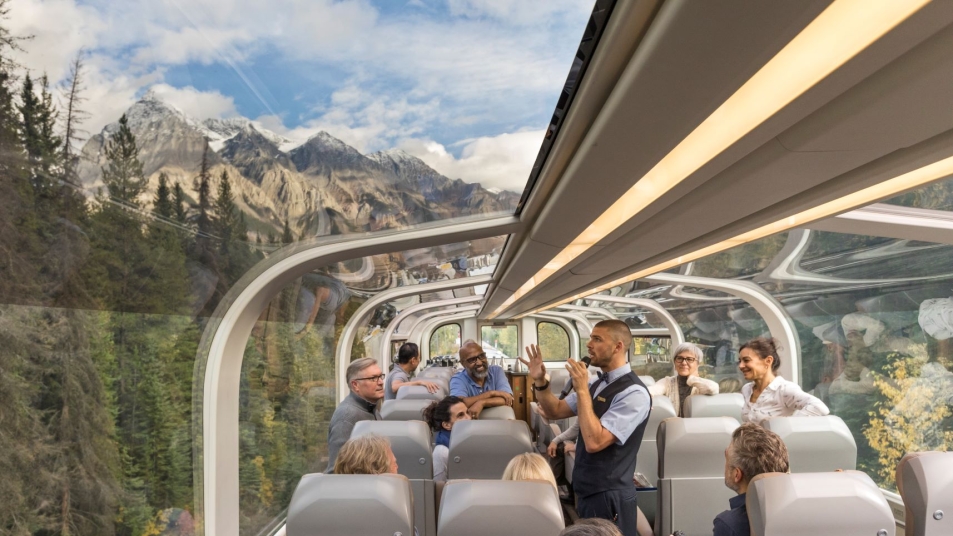Sit back, take a moment to relax, and let the landscape reveal itself to you. Spanning from the subarctic to the towering Rockies, here are five of the most breathtaking methods to experience train travel in Canada.
Every young person in Canada has an experience related to the study of the Last Spike. In the year 1885, with a single swing of a hammer, the ceremonial spike was embedded into the Canadian Pacific Railway in Craigellachie, British Columbia, which connected the country through a transcontinental ribbon of steel.
In today’s world of air travel, train travel in Canada has shifted from a requirement to a pleasurable excursion. There is no doubt that much enjoyment awaits, as you unwind in a comfortable seat while the stunning Rockies, seaside beaches, or expansive prairies glide past the window of a passenger train. For those interested in a slow-paced travel experience to explore Canada, here are five excellent ways to see the country from the train.

- The pathway linking Windsor and Quebec City
Journey Time: 16 to 18 hours
Distance: Approximately 700 miles
The Windsor-Quebec City Corridor represents the most heavily trafficked segment of railway in the nation, serving as a vital connection between prominent urban centers such as Toronto, Montreal, and the capital city of Canada, Ottawa. The volume of passengers is sufficiently substantial to justify the development of a high-speed rail link, which is anticipated in the future. However, there is also a certain charm to be found here, particularly during an evening journey from Montreal to Quebec. Each street you traverse appears to culminate at the water’s edge, with the pavement sloping down to the banks of the Saint Lawrence River. The warm hues of amber and red during the late hours of the day reflect off the glistening church steeples. The allure of poutine, that delightful and cherished traditional French-Canadian dish, beckons. It may be enjoyed at a table set upon the cobblestones in Old Quebec, a fortified UNESCO World Heritage site that has its origins dating back to 1608.
- The route known as White Pass and Yukon
Journey Time: 2.75 hours
Distance: Approximately 40 miles
In 1896, gold was discovered by prospectors in a secluded area known as Dawson City. This remote and difficult-to-reach location attracted thousands of eager miners from across the globe. The small town is situated just below the Arctic Circle, at the junction of the Yukon and Klondike Rivers, not far from the towering peaks of the Rocky Mountains. In 1898, construction commenced on a more accessible and efficient route to navigate the mountains that divide Skagway, located on the renowned Alaskan Inside Passage, from Whitehorse, which is directly linked to the gold fields in the Yukon River watershed. Nowadays, cruise visitors can appreciate the stunning views of the rushing, white waters of the Stikine River, the salmon runs along the Anuk River, and, with a bit of luck, catch a sight of a grizzly bear.
- Rocky Mountaineer
Journey Time: Two days and one night 
Distance: Approximately 497 miles (Vancouver to Banff)
For train travel in Canada, the Rocky Mountaineer stands out as the premier scenic train. A multitude of routes traverse the most immaculate and unforgettable terrains of Western Canada. The most traditional route travels from Banff, located in the heart of the country’s first national park, to Vancouver, a gem on the Pacific Coast. Along the journey, passengers are treated to some of Canada’s most breathtaking scenery. Each route showcases views that ignite the imagination, including the Spiral Tunnels in Kicking Horse Pass and the iconic Stoney Creek Bridge on the First Passage to the West. Interpreters provide insights into the significance of everything the train encounters, including the vital coastal rainforests and the dramatic Fraser Valley and Canyon, which spans 167 miles across a rugged Gold Rush region, characterized by turbulent waterfalls, steep cliffs, and profound gorges. What is the most impressive element of an expedition aboard the Rocky Mountaineer? You won’t miss a moment of the stunning scenery. The train halts for an overnight stay where passengers have booked their accommodations in Kamloops. Thus, on the second day, passengers are refreshed, alert, and seated by their windows as the train descends through the coastal Cascade Mountains towards the Pacific Ocean. Consider indulging in the GoldLeaf service in a carriage car that boasts a glass dome for the best views.
- Winnipeg to Churchill
Journey Time: Two days
Distance: Approximately 1,056 miles
It is a lengthy journey, traversing the tundra, with the train making its way to Hudson Bay and the various Arctic icons that inhabit this icy region. Upon your arrival, you will encounter some of the most coveted wildlife in the Far North, including beluga whales, but predominantly polar bears. Churchill is a quaint village with a population of fewer than 1,000 residents, located on the icy shores of Hudson Bay, at the terminus of the train route. It is recognized as the Polar Bear Capital of the World, located precisely along the yearly fall migration path of hundreds of bears. Experience the tundra by taking a buggy or enjoy a walk with these enormous, white-furred predators at Churchill Wild, which provides guided hikes among the bears. Return home with the most remarkable travel story of your life. As with any wildlife observation activity, it is essential to be responsible travelers, maintaining a safe distance while observing wildlife.
- The Canadian
Journey time: Four days and nights 
Distance: Approximately 2,796 miles
Experience a vast expanse of Canada on this journey that traverses from the heart of the country to the coastline. Departing from Toronto’s Union Station, the busiest transportation center in Canada, which accommodates approximately 300,000 individuals daily.
Throughout this journey, the landscape reveals the rich diversity of this immense nation, featuring the rugged beauty of the Canadian Shield and the extensive Great Lakes, which resemble true inland seas. Additional highlights include the Land of Living Skies found on the prairies, succeeded by the snow-covered summits of the Rockies as you progress towards the Pacific.
Best Railway Hotels
As Canadian Pacific established the nation’s first railway in the late 1800s, a recurring inquiry surfaced: “Who will be its passengers?” The then-president, William Cornelius Van Horne, remarked, “If we can’t export the scenery, we’ll import the tourists.” Indeed, visitors flocked from across the globe, relishing the picturesque views from the train before resting their heads in a collection of luxurious hotels established throughout the country.
Many of these establishments are true architectural marvels, such as the Banff Springs, the Royal York, and the Hotel Vancouver. The Fairmont Le Chateau Frontenac is arguably the most renowned hotel in Canada. Since its opening in 1893, its towers and turrets have continued to dominate the skyline of Vieux Quebec, a cobblestone gem that stands as the oldest fortified city north of Mexico. For those unable to stay overnight, dining at Champlain, their Michelin-starred restaurant, is highly recommended, where guests can savor contemporary Quebec cuisine alongside breathtaking views of the Old City and the St. Lawrence River.
Should you have the opportunity to spend a night here, we suggest the Celine Dion Suite, situated in the hotel’s original wing. This suite boasts a mauve and pink color scheme that reflects Dion’s personal style and is adorned with photographs from her personal photographer, capturing her extraordinary life and career over the years.
It is advisable to book a sleeper in Prestige class. Passengers not only benefit from a relatively spacious and comfortable room equipped with a private bathroom, but they also enjoy extra advantages, such as all-inclusive meal and bar service. The four-day, four-night journey becomes significantly more enjoyable upon reaching the ocean, especially after indulging in a locally sourced, three-course meal and having a restful sleep along the way.
